It’s a jungle out there! Today, we will show you all the harvests we made from our food jungle, take you on a tour of the California garden, and share some things for you to do in your garden this month. All this and a lot more coming up.
Harvests:
Let’s begin with all the harvests we made this month, starting with amaranth greens. We had a lot of amaranth growing in our raised beds, and as you can see, it looks beautiful. The flowers are also beautiful, but the leaves are the edible part. So, we’re going to harvest the leaves today. Since the plant has grown so big, we are harvesting the entire plant, cutting it down to prevent amaranth plants from spreading all over the garden.
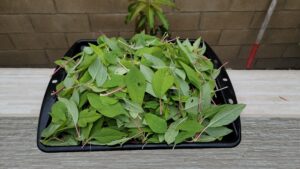
Amaranth Greens
Now, let’s move on to apples. Yes, you can grow a lot of apples in Southern California. From our four-in-one apple tree, we got a lot of apples. We were very happy with the apple harvest.
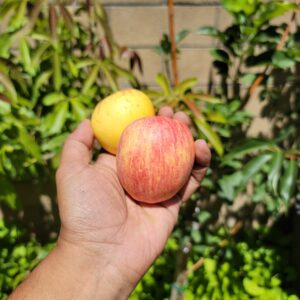
Apples
Between the raised beds on the trellis, we were growing all our beans, and July was the month when we harvested most of them. We have multiple varieties of pole beans, including the Kentucky Wonder pole bean and an heirloom pole bean variety. The benefit of growing beans on a trellis is that you can harvest a lot of beans from such a setup.
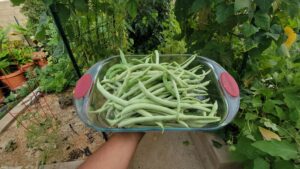
Pole Beans
We were also growing bush beans, which we compared to pole beans. Bush beans take up less space and are suitable for containers if you have limited space in your garden.
Next up, we have yard-long beans, which are delicious and unique. They require hotter weather but are worth growing if you can provide the right conditions.
Beets were also part of our harvest this month, though we didn’t have many. We grew a couple in a container, showing that you can grow beets alongside other vegetables in containers.
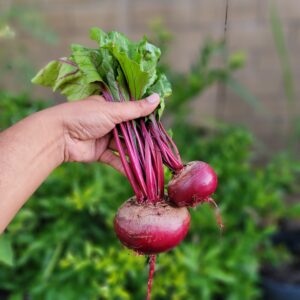
Beets
We also grew bitter gourds, a healthy but acquired-taste vegetable, and harvested a good amount of them from our container.
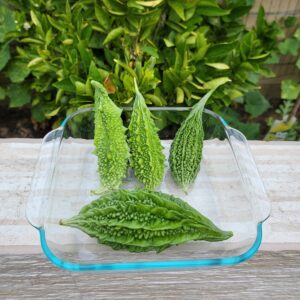
Bitter Gourds
Bottle gourds were grown in a container with a large trellis, producing beautiful round bottle gourds.
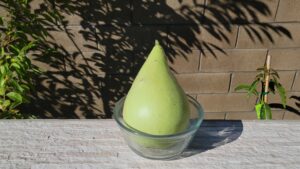
Bottle Gourd
While we didn’t have many butternut squash plants, they still yielded some nice butternut squashes, especially on the sides of containers where fruit trees were growing.
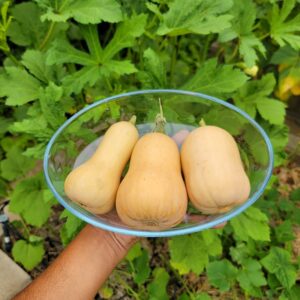
Butternut Squash
Cabbage, though not a hot-weather vegetable, produced a decent-sized head despite the heat.
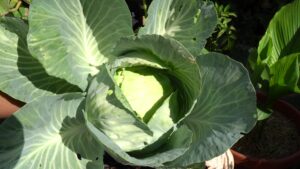
Cabbage
Cucumbers, particularly Armenian cucumbers, were a favorite in the summer garden. They grew very large and were harvested when they were ready.
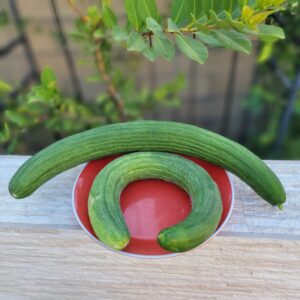
Armenian Cucumber
Eggplants were a star of the summer garden, with varieties like small Indian eggplant and medium-sized eggplant. They provided abundant harvests.
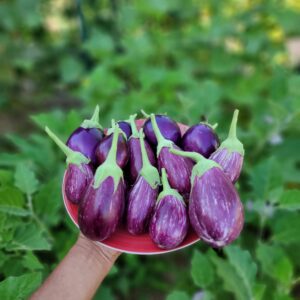
Eggplants
Figs were a delightful treat, with the Mission figs being highly praised for their taste.
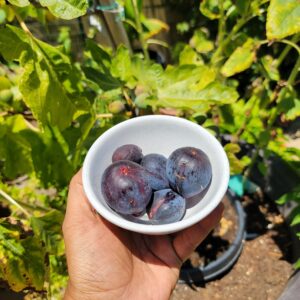
Figs
Little Miss Figgy, a dwarf plant, also grew in a container and produced unique-tasting figs.
Gardening Tips:
Okra, a heat-loving vegetable, produced a lot of tender and delicious okras during July and August.
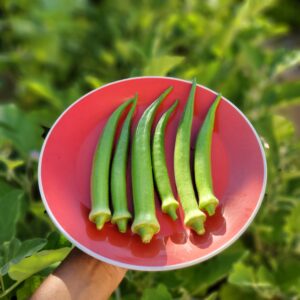
Okra
Onions were harvested, both from raised beds and a GreenStalk planter, with the latter showing impressive results.
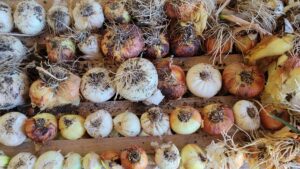
Onions
Several pepper varieties, including the Big Thai chili pepper, Bird’s Eye chili pepper, sweet bell peppers, hot banana peppers, hot cayenne peppers, and poblano peppers, provided a colorful and flavorful harvest.
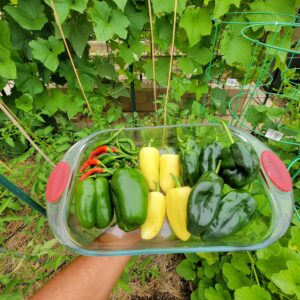
Peppers
Ridge gourds, also known as Chinese cucumbers, were harvested when tender. They were versatile and suitable for various dishes.
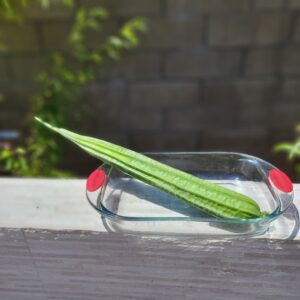
Ridge Gourd
The snake gourds continued to be harvested from containers, providing a unique vegetable with an acquired taste.
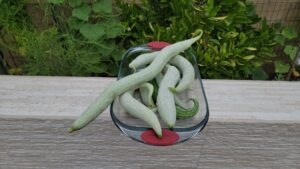
Snake Gourd
Swiss chard, similar to spinach, was harvested year-round in Southern California and was a nutritious and versatile green.
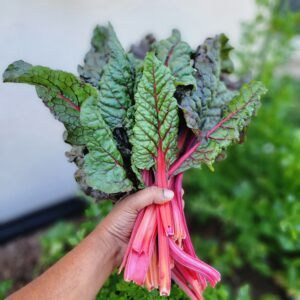
Swiss Chard
Tomatoes, including varieties like Delicious, Beefsteak-style, and Indian heirloom tomatoes, were abundant and delicious. Single-stem tomato plants were used for focused fruit production.
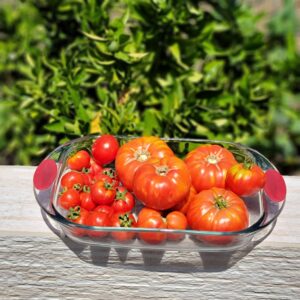
Heirloom Tomatoes
Garden Tour:
Starting with the raised beds, in our first raised bed, we planted a few tomato plants and some sweet potato plants. You can also see some plants that have grown from the compost we added to this raised bed. We have a lot of okra growing here; they’ve taken off now that the weather is perfect. The extra compost at the bottom provides nutrients to these plants.
On the other side, we have our pole bean plants growing on the trellis between our raised beds. You saw us harvest a lot of pole beans from these plants, and I’ve saved some of these bean pods for seed saving. On the other side, we have more bean plants. These are all pole bean plants, making it a nice area with plants on both sides.
We have Armenian cucumbers growing here, and in this bed, we have all our eggplants and peppers, mostly eggplants with a few pepper plants as well. These are Thai chilies, and we have different varieties of eggplants here, including the small and medium ones.
In the next raised bed, we have the Aswad eggplant, which produces really large eggplants. We also have beets, which are struggling a bit in the summer season, and okra, which is not doing as well in this patch as in the other one. However, the red okras or burgundy okras are still producing well.
Moving on, you can see our ridge gourd plant, which has grown like crazy, with lush foliage and producing a lot of rich gourds. Summer is the time when most of these gourds grow well.
Next up, we have pepper plants in the raised bed, including poblano peppers and Santaka chili peppers, which are very hot. We also have a lot of tomatoes in the next batch, which are volunteer plants from the compost.
Now, let’s look at our cucumbers. We have several cucumber plants growing on a sturdy trellis made by zip-tying tomato cages together. There’s a variety called dosakai growing well, and several other cucumber varieties will grow soon.
Moving on to the final raised bed, you can see our single stem tomatoes have grown well and are still producing a lot of tomatoes. They need some pruning, which I’ll get to soon. We also have a corn patch nearby with beautiful tall corn plants.
Next to the corn, we have a couple of pepper plants, the Yolo pepper, followed by our taro root plant and ivy gourds. The ivy gourd plant is producing a lot of fruits on the trellis behind it.
Things To Do:
Now, let’s look at some things to do in your garden this month. In the summer season, you need to watch out for plants like basil, which will start bolting and producing flowers. Make sure to prune them. The same goes for cilantro; prune it to harvest because it tends to bolt in the hot summer season.
Planting is also important. You can label your plants using a thermal label printer and attach the labels to popsicle sticks. This helps you keep track of the plants you’re planting. Use a seed starting mix, such as coconut coir and vermiculite, to start your seeds. Ensure the mix is moist by gently watering it.
In August, it’s a good idea to start cool-season crops like broccoli, spinach, cauliflower, cabbage, and beets. Directly sow seeds like carrots in containers. This is a good time to start your carrot seeds.
Watch the video here California Garden Becomes a Food Jungle! Vegetable Garden Tour, Gardening Tips & more!

YTLogo
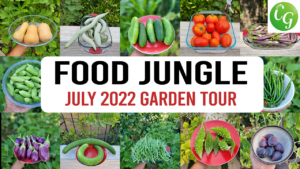
YTLogo
So, that wraps up our blog for this month. If you found this useful, please comment and subscribe to my YouTube if you haven’t already. Happy gardening!

0 Comments